Get to know Artists Pens – Fineliners & Technical Pens
Fineliner pens are favoured by artists looking to create detailed and precise linework. Their plastic or fibre nibs are usually long and in metal casing so they can be used with a variety of sketching accessories like rulers and templates without catching. They are mostly disposable, although some like the FW Mixed Media Technical Marker Pen can be refilled.
At Ken Bromley Art Supplies we offer a great selection of pens suitable for a whole range of creative applications. From technical pens to brush pens we have everything you’ll need to fulfil your artistic expression. Fineliner pens are used when precision and detail are paramount, and are great for creating crisp illustrations and detailed drawings. Small and portable, they are a great tool for drawing and sketching – water resistant fineliners are also great for line and wash techniques! Choosing the perfect fineliner for your work will depend on a few different factors – like the type of mark you wish to make, the size of work you are making, which surface you are using and the type of ink you require. We have compared the fineliner pens that we stock to help narrow down your choices!
Faber-Castell PITT Artist Pens
Faber-Castell PITT Artists Pens are one of our best-selling fineliner pens. Filled with a pigmented Indian Ink, they offer artists a line with high light resistance. Odour-free, acid-free and pH neutral the PITT pen will ensure your work is around for years to come. Each fineliner is filled with a water-resistant-permanent pigmented ink, which makes them a popular choice for artists working with multiple watercolour and ink washes. Usable on various surfaces including paper, canvas and wood; these pens can be easily incorporated into any mixed media technique so you can sketch with confidence!
In our test these liners stood up well to repeated watercolour and ink washes, with the original linework showing no bleeding or smudging at all. This pen also had one of the the blackest, most crisp lines of the fineliners tested, a quality it shares with the Sakura Pigma Micron range. Ideal for detailed work, the ink in these pens was free-flowing which resulted in crisp, skip-free lines.
Faber-Castell PITT pens are available in three colours; sepia, sanguine and black. Both the sanguine and sepia pens are available in four different nib sizes – from Superfine through to Brush. The black pen is available in the additional size of Extra-Superfine. Selected sizes are also available in assorted wallet packs.
> Shop online for Faber-Castell PITT Artists’ pens
Sakura Pigma Micron Pens
Artists and illustrators worldwide reach for their Sakura Pigma Micron pens when accuracy and preservation are paramount. These fantastic pens can render even the finest details with accuracy and are filled with archival quality pigmented ink so your artwork will stand the test of time. Their fine point allows for skip-free drawing that will leave your linework consistent. Made with specially formulated Pigma Ink, Micron pens have become the defining standard for reliable, permanent, archival quality ink. Coloured Sakura Pigma Micron pens are also available if you’re looking to add a bit of vibrant colour to your sketches. There are thirteen colours in this range, all in a 0.45mm nib size.
When tested these pens were one of the two top performers, along with the Faber-Castell PITT Artists’ pens. Their ink was among the blackest of the pens we tested, only tied with the PITT pens, and showed no movement when a watercolour wash was applied over the top. As they are slightly less pricey than the PITT Artists’ Pen they would make a great choice for anyone wanting to create pen sketches on a budget but without compromising quality.
Sakura Pigma Micron Pens are available individually in seven nib sizes ranging from 0.2mm to 0.5mm, and in two different assorted sets.
> Shop online for Sakura Pigma Micron Pens
Uni Pin Fine Line Pens from Uni-ball
Uni Pin Fine Line Pens from Uni-Ball are an affordable drawing and sketching tool that are perfect for inking even the smallest of details. The range covers a vast 11 nib sizes, including a brush tip, and the black variant is available in all 11 of these sizes. Light grey, dark grey and sepia toned pens are also available in a more limited range of nib sizes. This versatile range has everything you’ll need to sketch out your most creative ideas and are great for adding a finishing flourish to your artwork. All pens from this range are both water and fade proof.
The Uni Pin is the most affordable fine liner pen that we stock, at only £1.75 per pen, but certainly does not compromise on quality. It stands up well compared to more pricey pens, both in terms of the darkness of the ink and also water resistance. Their ink is only slightly paler than the Sakura and Faber-Castell liners, and their ink did not budge even with a very heavy wash. They offer great value for money for anyone looking to try out a fineliner pen on a budget.
> Shop online for Uni Pin Fine Line Pens from Uni-ball
Edding 1800 Sketching & Drawing Pen
The Edding 1800 Drawing and Sketching pen is a sturdy and durable fineliner with a metal cased synthetic tip. This popular pen works smoothly across a variety of papers, and its permanent lightfast ink means your artwork will not fade or deteriorate over time. Available in 4 sizes, with a 0.1 (0.25mm) being the smallest available nib, the Edding 1800 is excellent for detailed and intricate work.
The Edding 1800 is pricer than its more affordable 1880 cousin, but from testing it is apparent that the linework is much darker and crisper. The free flowing ink was much blacker and created a smooth, skip-free line. With a durable build quality and long lasting ink this pen would be ideal for creating top-quality line work. The only downside to this pen was the limited nib range. Although they have four sizes ranging from a 0.1 to a 0.7 nib, some may find that they require more variation that a larger range would provide.
The Edding 1800 is available individually in 4 different nib sizes.
> Shop online for Edding 1800 Sketching & Drawing Pens
Edding 1880 Drawliner Pens
The Edding 1880 Drawliner is the Edding 1800’s more affordable cousin. Great for artists’ and illustrators working to a budget, this affordable fineliner offers a strong fibre tip with a metal frame. Filled with water-resistant, lightfast black pigment ink, these pens are ideal for building up layers of small detail.
These pens showed no bleeding when used with watercolour, although their ink was not as black as some of the other pens tested. They are a great, affordable pen for anyone looking to experiment in this medium.
Edding 1880 pens are available individually in 5 nib sizes, or in a pack of 4
> Shop online for Edding 1880 Drawliner Pens
Derwent Graphik Line Makers
Line Makers (previously Graphik Line Makers) are a fineliner developed by Derwent. These pens are available in 3 different colours, each made with water-based pigment ink. Fitted with Japan nibs available in up to 6 different widths, these liners are excellent for producing fine detail and can be used seamlessly with Derwent Paint Pens. Although the ink in the Line Makers is not water soluble, they can be layered over dry designs created with the Line Maker to add an extra flair of detail.
When a watercolour wash was applied over the top of these liners the black ink did have a tendency to bleed. The sepia and graphite ink showed minimal, if any bleeding at all. Occasionally the ink in these pens also created a small pool of ink at the end of the stroke. This is great for creating the look and feel of a traditional dip pen drawing with varied line widths, but may be inconvenient for those who want crisp line work.
Available in Black, Graphite and Sepia each sold individually or in sets. The sets also feature some great designs by Derwent collaborator Carne Griffiths, sure to fill you with inspiration!
Derwent Graphik Line Makers are individually in 6 nib sizes (Black) or 3 nib sizes (Graphite and Sepia), or in assorted wallets.
> Shop online for Derwent Line Maker Pens
FW Mixed Media Paint Marker – Technical Nib
The FW Mixed Media Paint Marker range are the newest innovation from Daler Rowney. These groundbreaking pens can be filled and refilled with most of your favourite water-based media. Ever found that you’re struggling to find a pen that matches your colour scheme? Mixed Media paint markers break the restriction of a manufacturers palette; mix and fill your marker with custom created colour. Choose from a whole variety of water-based media; although they are designed to work seamlessly with FW Acrylic Inks, they can also be used with watercolour, Brusho and a range of water-soluble crayons and blocks. The resistance of your pen to water will depend entirely on what you fill your marker with. The pen in the above example has been filled with Black Indian Ink, which is water resistant and so can be used with watercolour or ink washes.
Although there are multiple nib sizes in the range, the finest of them is the 0.8mm technical nib, suitable for creating fine linework.
> Shop online for Daler Rowney FW Mixed Media Paint Markers
> Find out more about Daler Rowney FW Mixed Media Paint Markers
Which fineliners are waterproof?
Almost all the fineliners that we stock can be used with a line and wash technique without your linework bleeding. One exception to this is the Derwent Graphik Line Marker pen. This pen may resist a little water, but if a particulary wet wash is applied your linework will bleed. The bleeding is most noticeable with the Black Line Maker, but is less pronounced with the Graphite and Sepia pens. Out of the fineliners that we stock the Faber-Castell PITT Artist Pens and the Sakura Pigma Micron are the most popular choices for a line and wash technique. The FW Mixed Media marker can be filled with a water resistant ink, like Black Indian Ink, if you are looking for a water resistant 0.8mm line.
Which fineliners have the darkest ink?
Out of all the fineliners that we stock it was a tie between the Faber Castell PITT Artists Pens and the Sakura Pigma Micron range for which had the blackest ink. The Uni Pin Fineliners were a close third, followed by the Edding 1800. Both the Edding 1880 and the Derwent Line Makers had a slightly paler ink in comparison to the rest of our fineliners.
Nib Sizes
The fineliners that we stock come in a wide variety of nib sizes – from the smallest 0.03mm nib up to the thickest 0.8mm nib. Different brands will supply their pens in a variety of nib sizes, with some sizes only being available from certain manufacturers. This chart shows a comparison of the nib sizes across the ranges of fineliners that we stock.
| Nib size (mm) | ||||||||||||||
| 0.03 | 0.05 | 0.1 | 0.2 | 0.25 | 0.3 | 0.35 | 0.4 | 0.45 | 0.5 | 0.6 | 0.7 | 0.8 | Brush | |
| Faber Castell Black Pitt Pens | x | x | x | x | x | |||||||||
| Faber Castell Sepia Pitt Pens | x | x | x | x | ||||||||||
| Faber Castell Sanguine Pitt Pens | x | x | x | x | ||||||||||
| Sakura Pigma Micron Pens | x | x | x | x | x | x | x | x | ||||||
| Unipin Fineliners Black | x | x | x | x | x | x | x | x | x | x | x | |||
| Unipin Fineliners Dark Grey | x | x | ||||||||||||
| Unipin Fineliners Light Grey | x | x | ||||||||||||
| Unipin Fineliners Sepia | x | x | ||||||||||||
| Edding 1800 | x | x | x | x | ||||||||||
| Edding 1880 | x | x | x | x | x | |||||||||
| Derwent Graphik Black | x | x | x | x | x | x | ||||||||
| Derwent Graphik Graphite | x | x | x | |||||||||||
| Derwent Graphik Sepia | x | x | x | |||||||||||
| Daler Rowney FW Marker Tech Nib | x | |||||||||||||

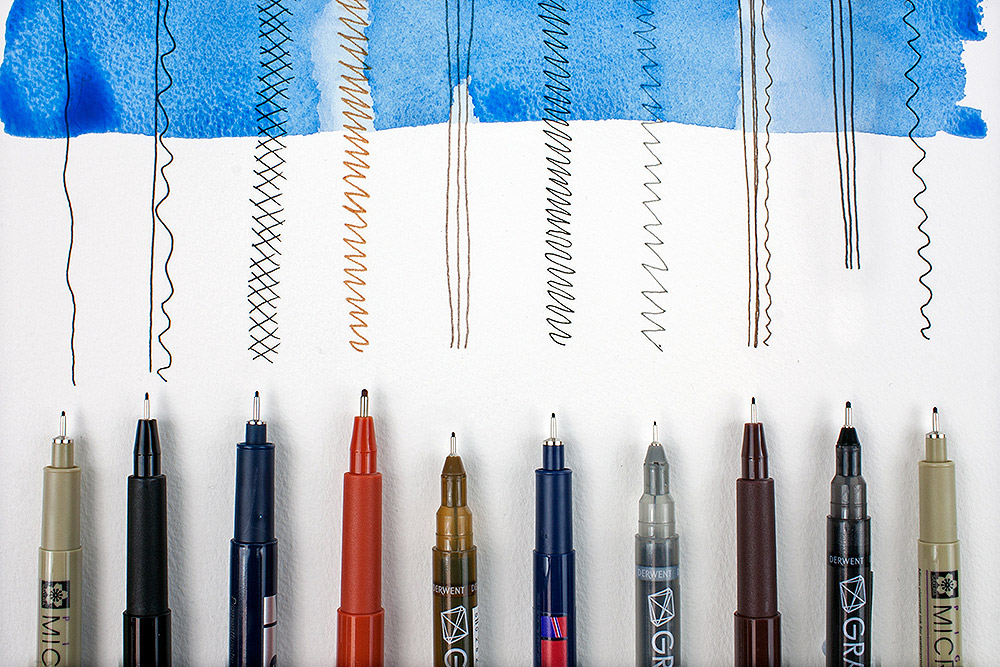
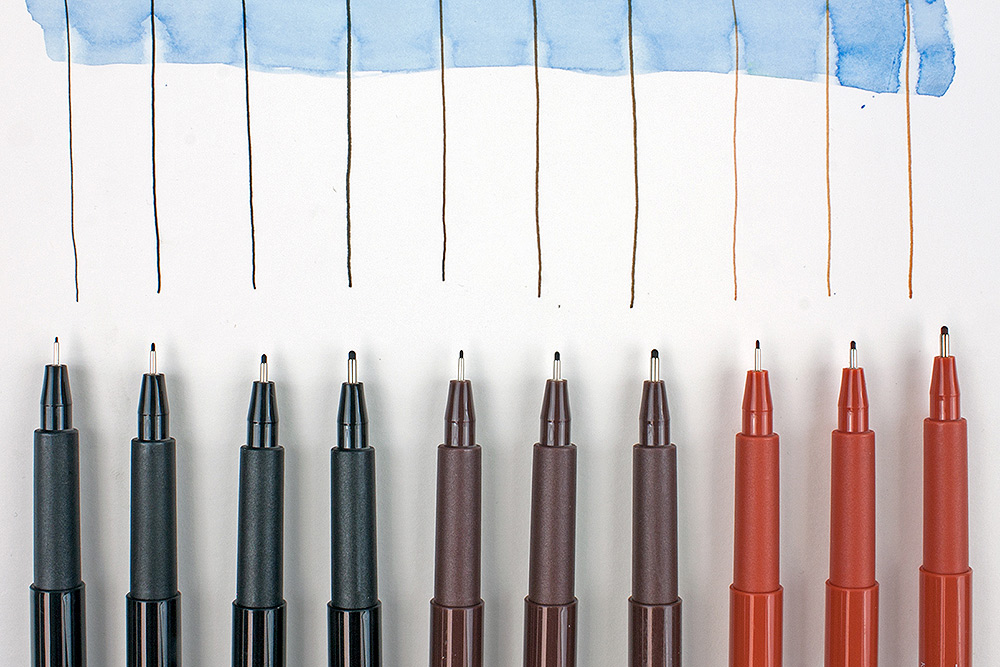
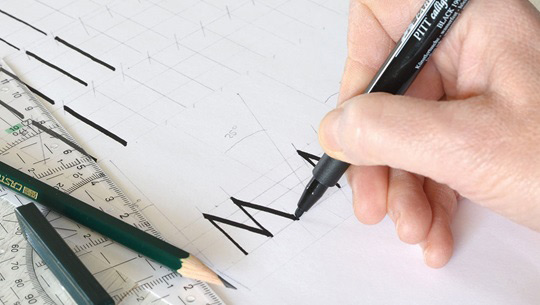
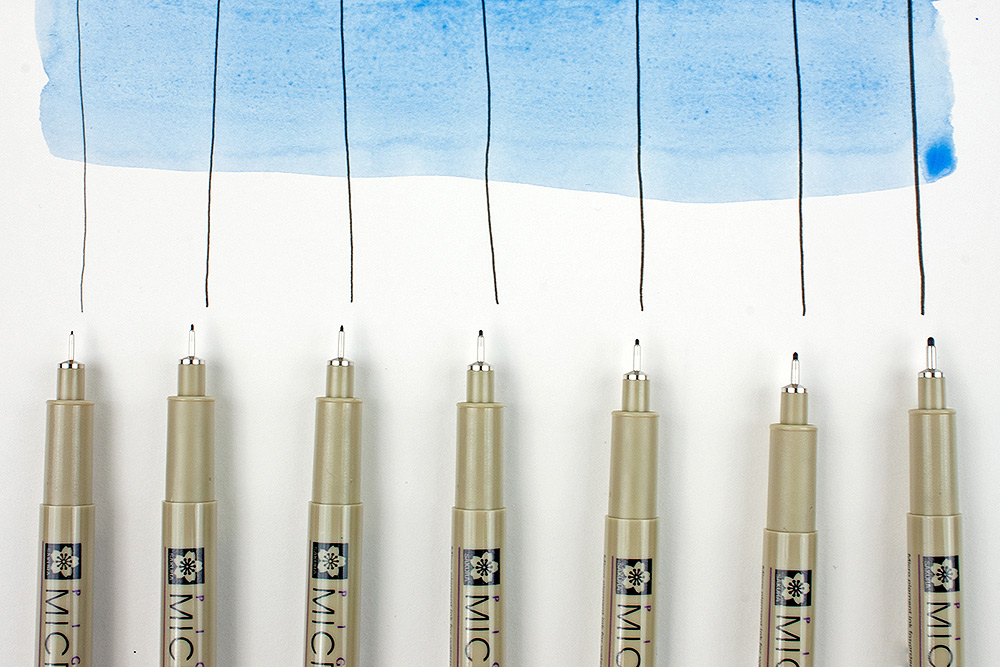
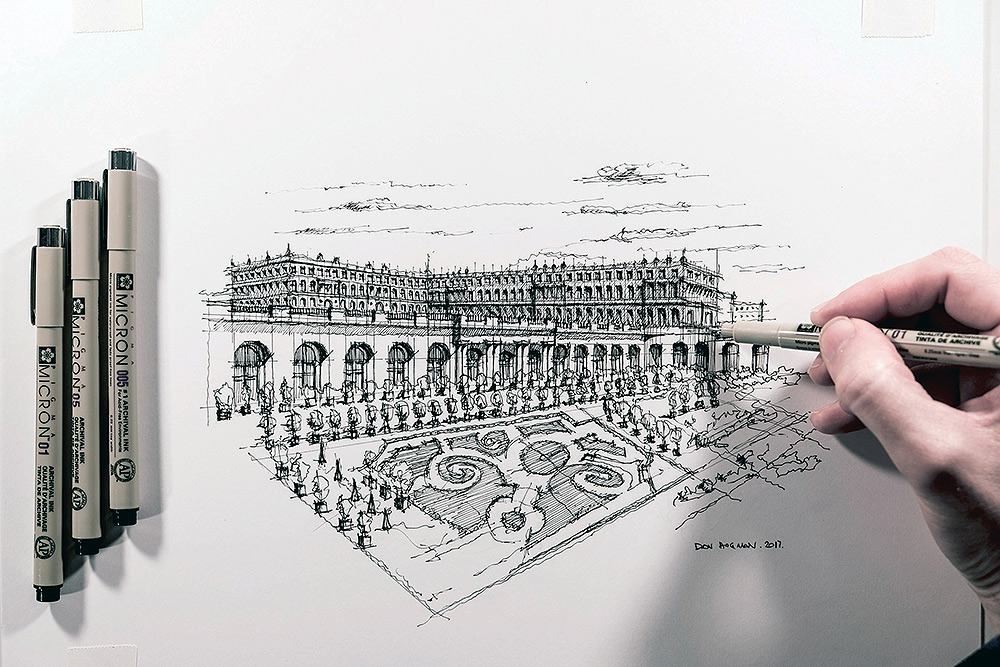
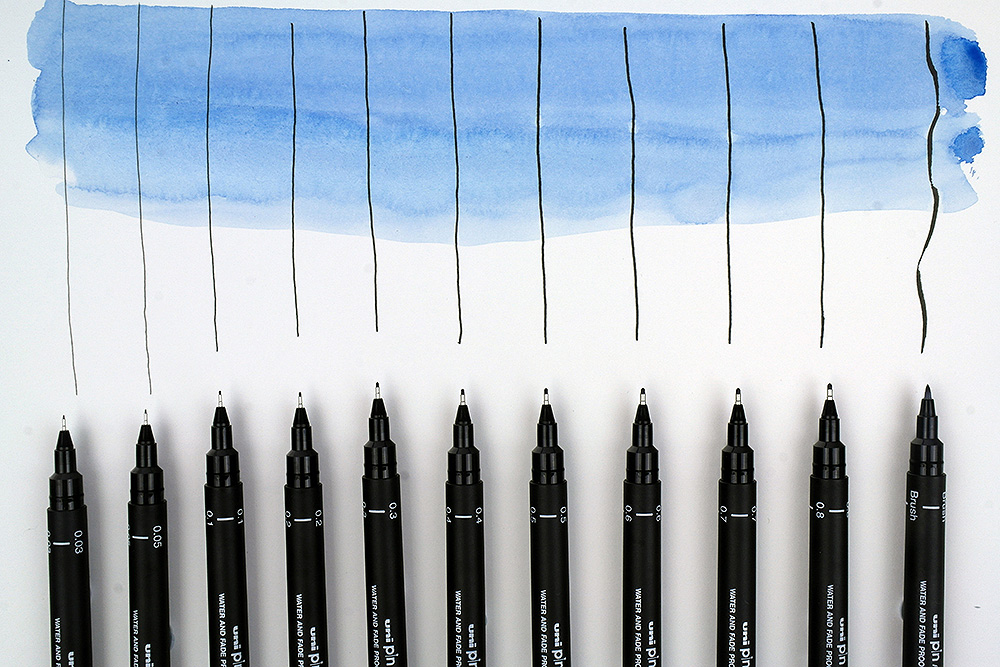
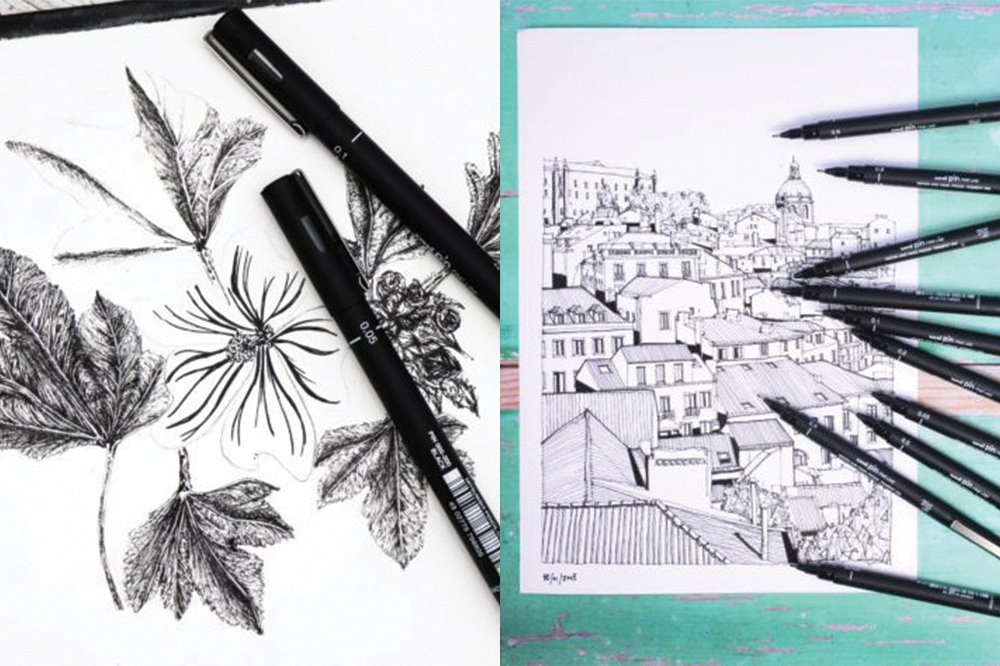
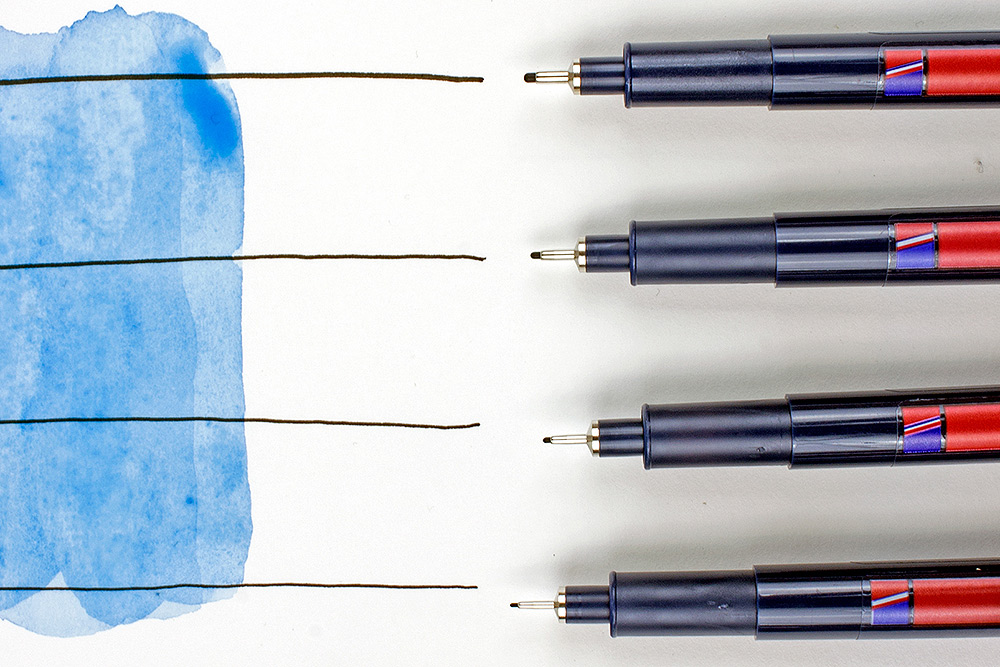
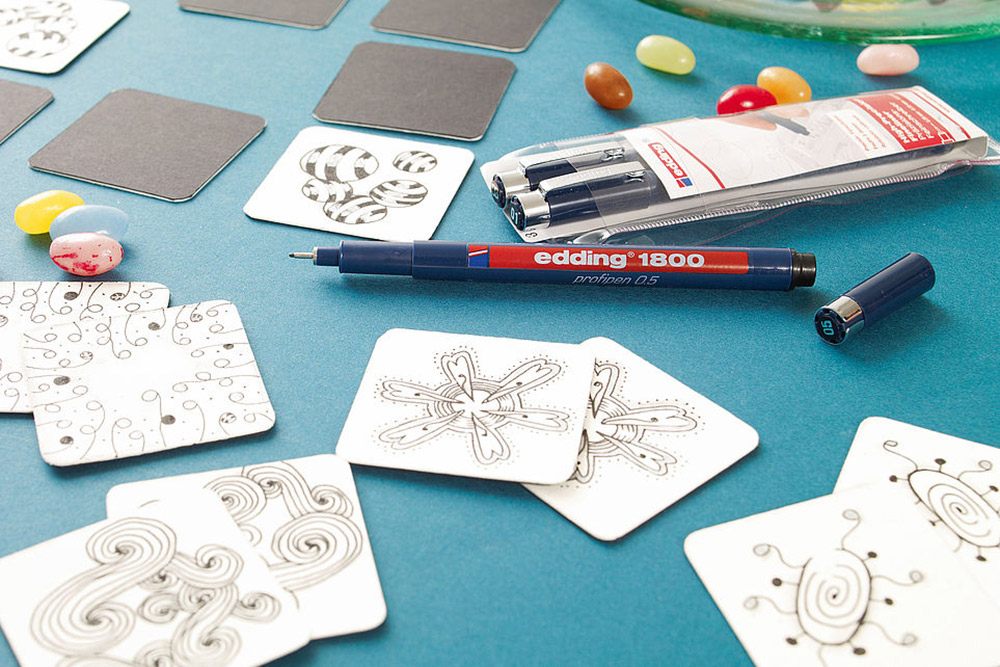
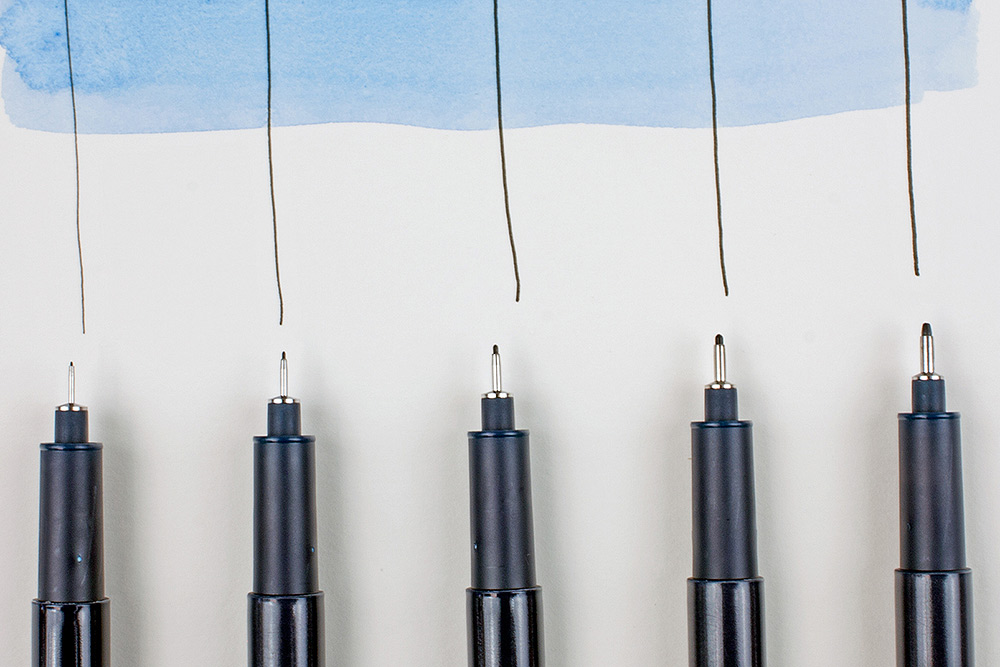
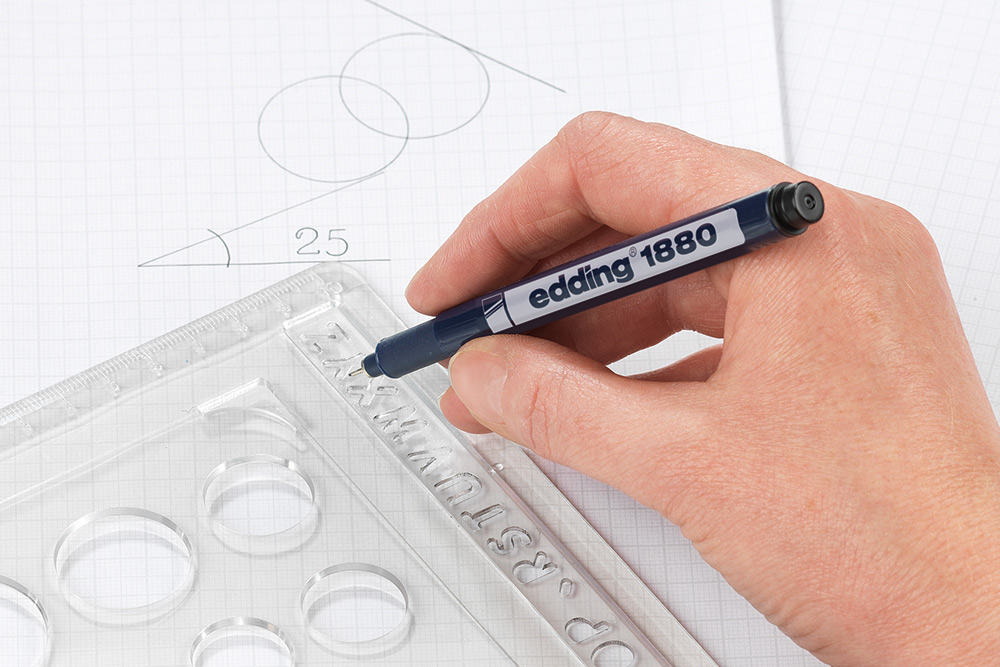
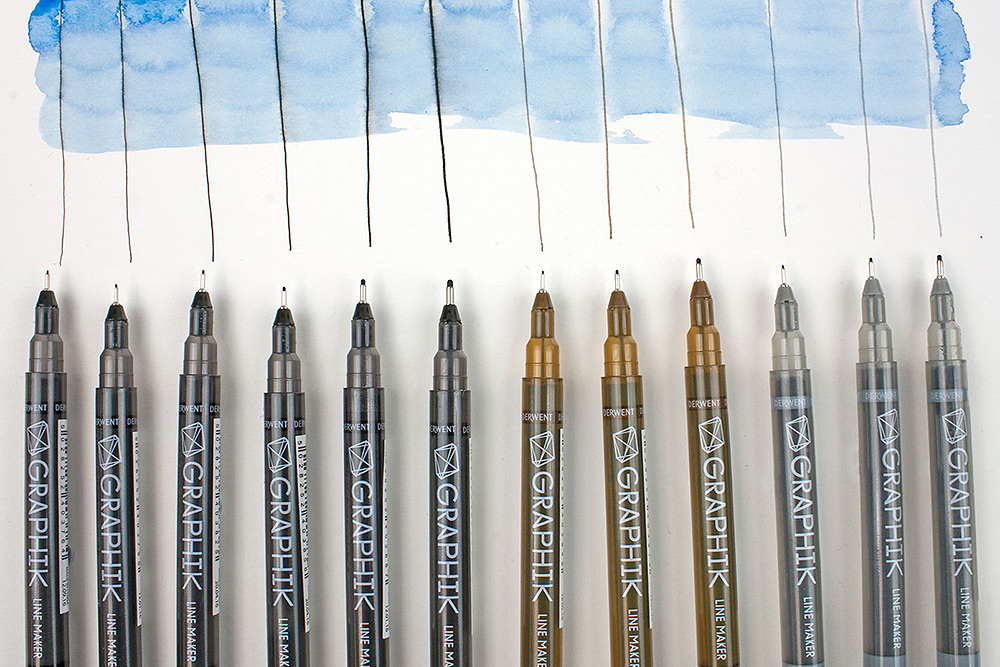
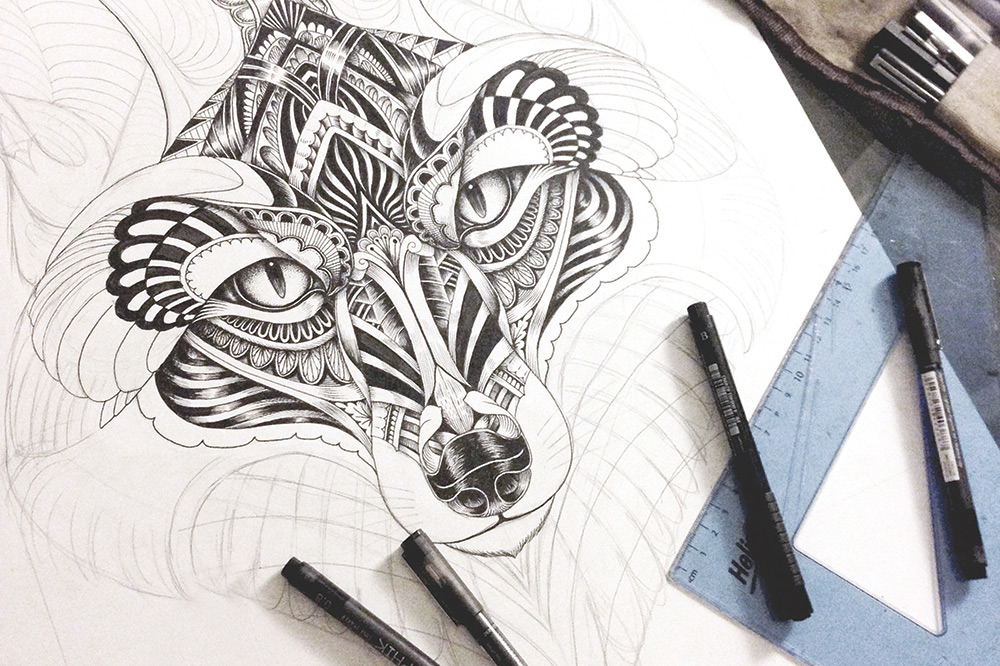
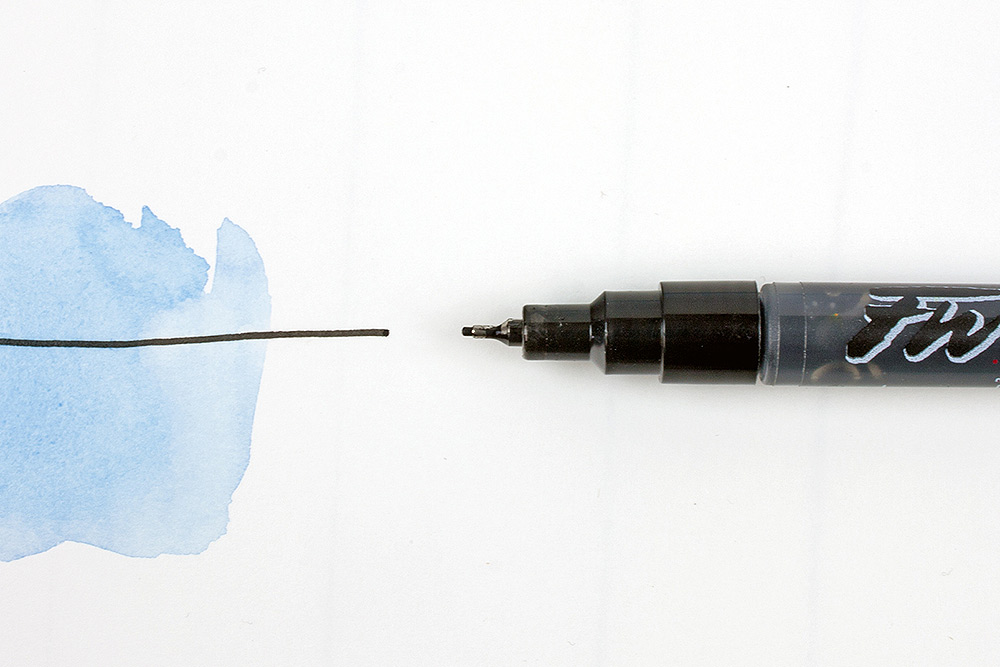
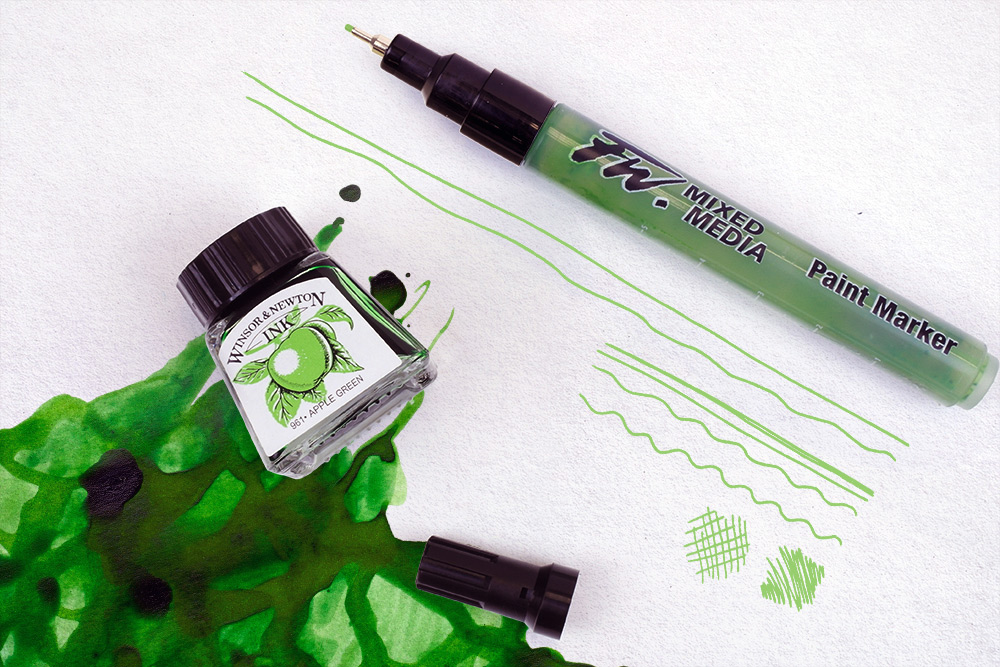
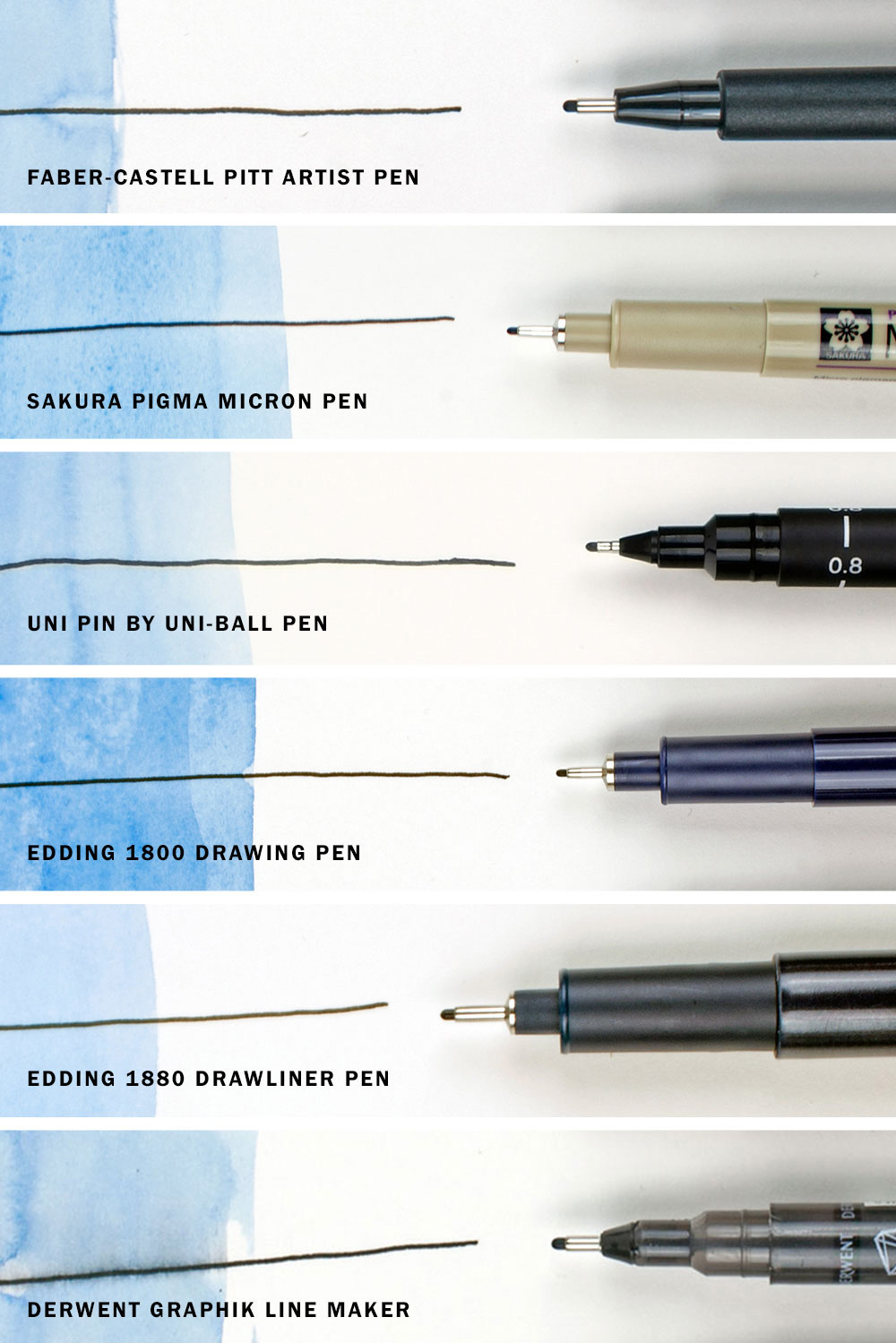
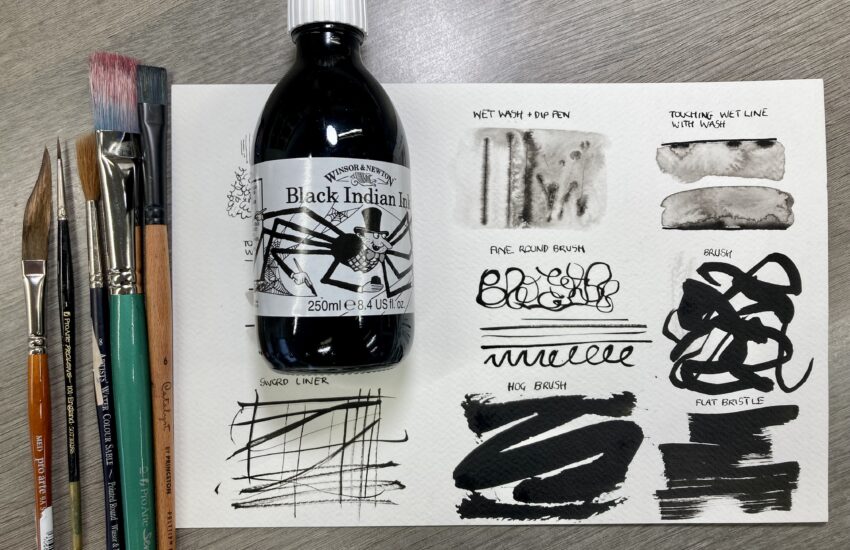
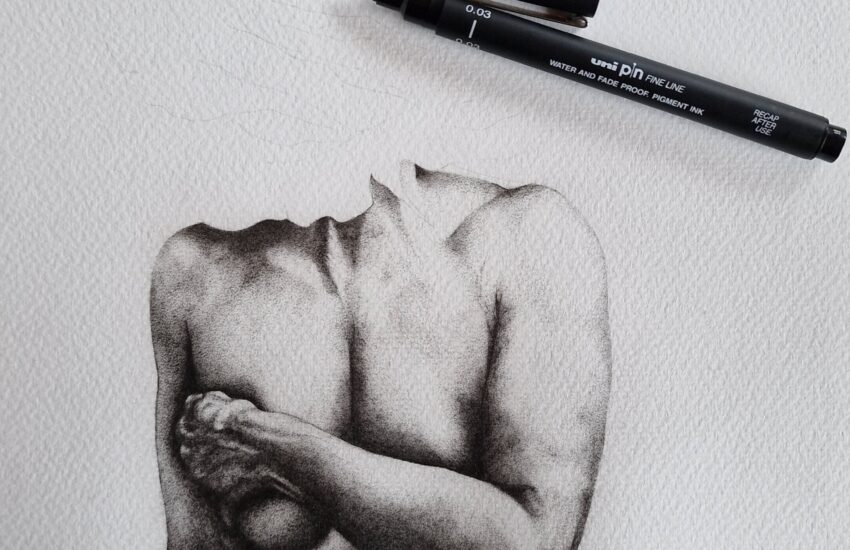
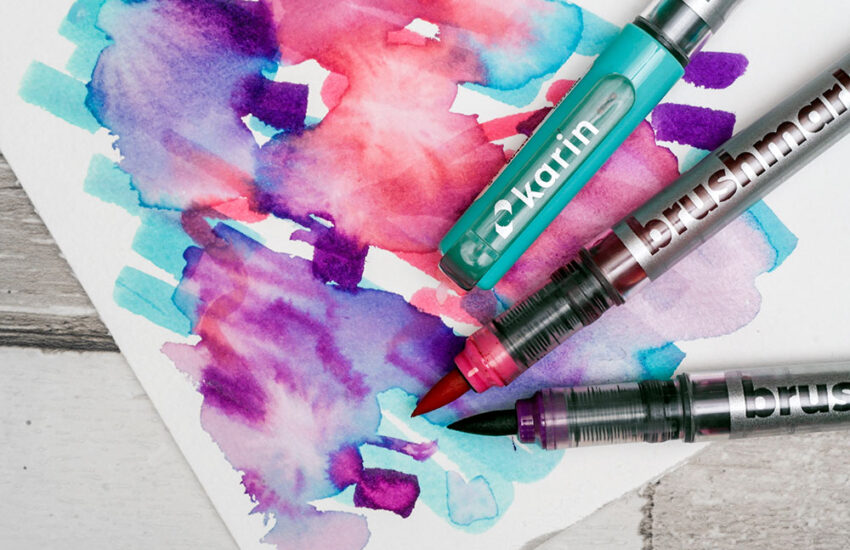
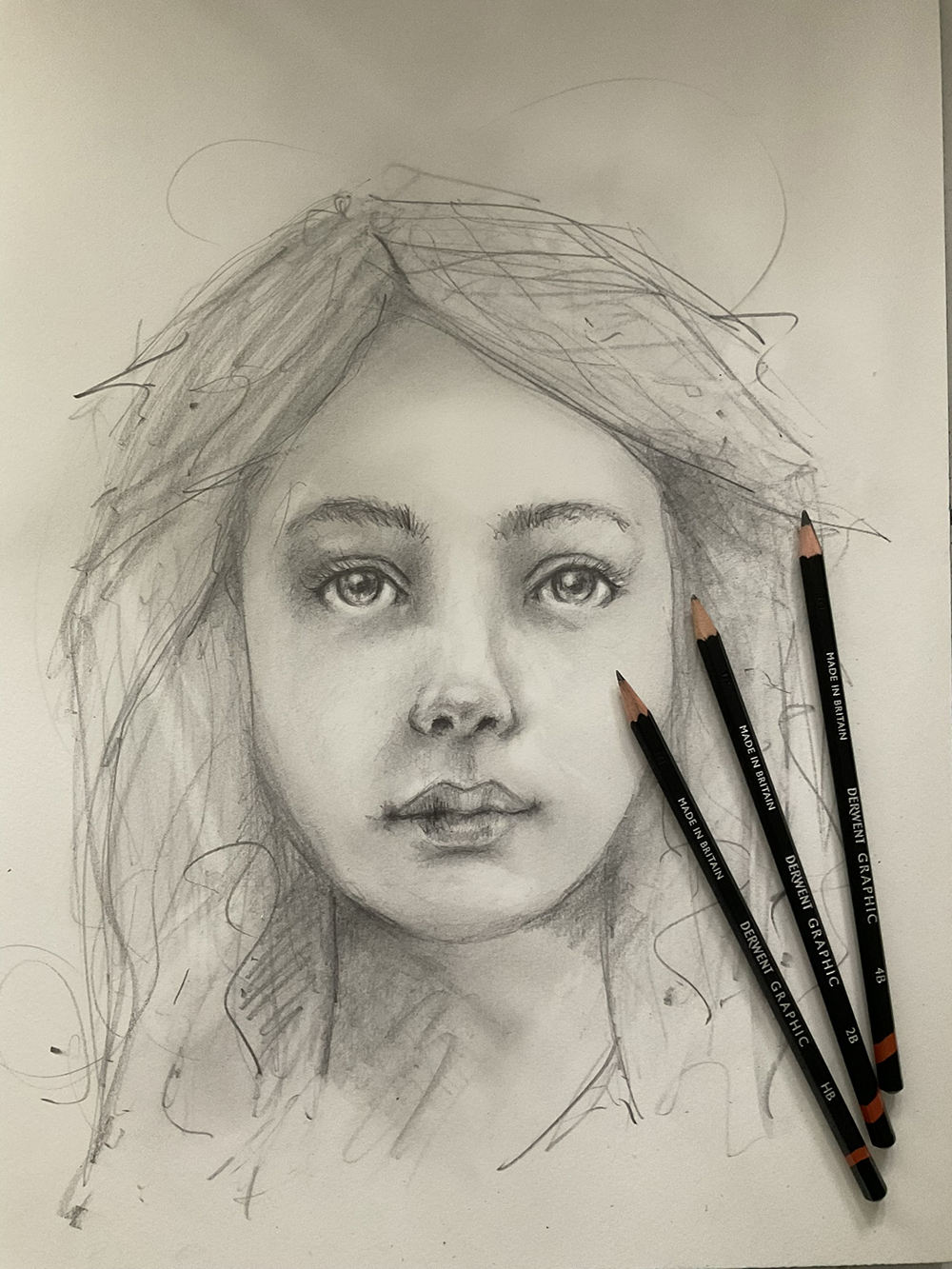


Great article! I found it through a Google image search, while looking for a comparison of the thinnest of the top brands of fineliners. But I was a bit disappointed when I got to the bottom, and found that your comparison was a spreadsheet, rather than a side by side comparison. (Still a great article though!)
I would love to see a side by side comparison of lines drawn by each the top pens in the finest nib sizes that they offer. (Not by what is labeled on each pen. But just the smallest offered.)
There are discussions on various social media boards debating which pens are ACTUALLY the thinnest, despite what size they are labeled as being. That some are not really producing lines as thin as they say they can.
Some artists swear that dispite pens being labled as being a size larger than other brands, they seem to draw lines even thinner. This is theorized by some to possibly be due to the ink spread/paper penetration, but I would love to see if this is true when lines are drawn on the same paper, side by side.
I’m very curious, because maybe the artists that are stating this are mistaken. It’s possible that they think they are comparing their experience with different pens, but don’t realize they may be actually comparing ink spread on different papers.
OR maybe it IS due to different inks? (Pigment ink vs dye ink maybe?)
OR, maybe they are right. Maybe some companies ARE using dishonest labeling. I’d really love to see the differences. 😊
Thanks again for a excellent article!
Hi Alana. Happy to hear you enjoyed the article! Thank you for your suggestion, it sounds like a great idea; we’ll certainly see if we can add a side-by-side comparison of lines drawn by our fineliner ranges. Ah, that’s interesting! It’s not a problem that we’ve heard of. In our tests for the blog post, I found that ink composition, paper quality and even the type of surface used play a significant role in the variations of line quality. So really any of those things could contribute to the weight and feathering of the line that the artists have been experiencing.
Hi, excellent article. Do you know what to prep a canvas with before using a fine line felt tip marker? My friend keeps breaking her pens and wants to create a smoother surface that the pens will still work on
Hi Tracey. Thanks for your comment. Canvas typically has a textured surface which is primed with gesso that gives it a bit of ‘tooth’. This texture is great for the adhesion of oils, acrylics and other types of paint, it isn’t typically a surface that you’d use with felt tips. Canvas can be primed with more gesso and sanded between layers to smooth it out, but it might be worth thinking about whether canvas is really the best surface for your medium? Smooth surfaces like card and paper are much better suited to pens and will give much better results.
You could also look at the type of pens used. Felt tips typically aren’t lightfast, and if your canvas is being displayed you’ll probably find that it fades or the colours change over time. If you are set on using pens on canvas it may be worth looking into paint markers like Liquitex and POSCA, or refillable FW Mixed Media markers that would be more forgiving and durable on this type of surface.
Fantastic report. Thanks!
Hi, I think your table is missing the 005 and 01 of the Sakura Pigma Micron pens, which are also available on your website? Great overview, thank you.
Hi Ayla. Thank you for your comment! We’re glad to hear you liked the article. Our chart works off the size in mm of the nib rather than each individual manufacturers sizing scales to allow us to do a direct comparison across brands. They should be included in the chart but with their measurement in mm rather than the manufacturers size – so 0.2mm for the 005 nib and 0.25mm for the 01. Hope this clears things up!
As someone who used (and battled with) Rotring refillable pens, this is an excellent survey. Very useful to know the finest nib available, as well as the darkest.
Hello Ken Bromley, Thanks for your comparison of fine liner pens which is very interesting. I currently use the Sakura range which are excellent.
I wondered which papers you used for your tests and if you have any recommendations. Perhaps you could do a comparison of papers for graphic work.
Hi Steve, most of them are on the old Winsor & Newton Professional Paper Hot Pressed. The Uni Pin ones were done a bit later on though and that was done on the pad of Canson Mixed Media paper as we had run out of the W&N paper by then. We can definitely look at doing a paper comparison blog post in the future – we are always looking for ideas and suggestions as to what our customers would like!
What an incredibly helpful survey – thank you very much.